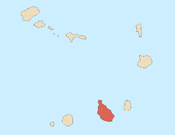
The recorded history of Cape Verde begins with the Portuguese discovery of Cape Verde in 1456. Possible early references to Cape Verde date back at least 2000 years.
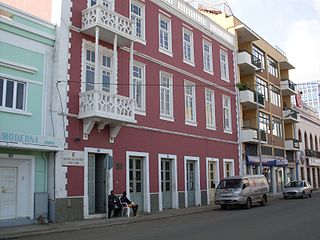
Praia is the capital and largest city of Cape Verde. Located on the southern coast of Santiago island, within the Sotavento Islands group, the city is the seat of the Praia Municipality. Praia is the economic, political, and cultural center of Cape Verde.

Cidade Velha is a city in the southern part of the island of Santiago, Cape Verde. Founded in 1462, it is the oldest settlement in Cape Verde and its former capital. Once called Ribeira Grande, its name was changed to Cidade Velha in the late 18th century. It is the seat of the Ribeira Grande de Santiago municipality.

Santiago is the largest island of Cape Verde, its most important agricultural centre and home to half the nation's population. Part of the Sotavento Islands, it lies between the islands of Maio and Fogo. It was the first of the islands to be settled: the town of Ribeira Grande was founded in 1462. Santiago is home to the nation's capital city of Praia.

Ribeira Grande de Santiago is a concelho (municipality) of Cape Verde. It is situated in the southwestern part of the island of Santiago. Its seat is the city Cidade Velha. Its population was 8,325 at the 2010 census, and its area is 137.3 km2.
The Santiago South Premier Division is a regional championship played in Santiago Island, Cape Verde and is a part of the Santiago South Zone Football Association. The winner of the championship plays in Cape Verdean football Championships of each season while the last two placed clubs relegates in the following season. In 2007 and 2013 when Sporting Praia automatically qualified in the championships as they won their national titles in the previous season, a second place club qualified to the national championships. The division features 12 clubs in the premier division for the second time, Varanda and Delta were relegated into the Second Division, Tchadense and Benfica were promoted last season.
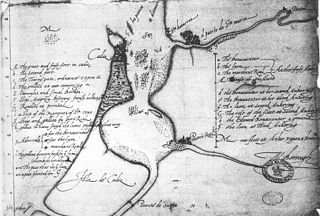
Singeing the King of Spain's Beard is the derisive name given to a series of attacks by the English privateer Francis Drake against the Spanish in the summer of 1587, beginning in April with a raid on Cádiz. This was an attack on the Spanish naval forces assembling in the Bay of Cádiz in preparation for the planned expedition against England. Much of the Spanish fleet was destroyed, and substantial supplies were destroyed or captured. There followed a series of raiding parties against several forts along the Portuguese coast. A Spanish treasure ship, returning from the Indies, was also captured. The damage caused by the English delayed Spanish preparations for the Armada by at least a year.

Cape Verde was a colony of the Portuguese Empire from the initial settlement of the Cape Verde Islands in 1462 until the independence of Cape Verde in 1975.

The Raid on St. Augustine was a military event during the Anglo-Spanish War in which the Spanish settlement of St. Augustine in Florida ) was captured in a small fight and burnt by an English expedition fleet led by Sir Francis Drake. This was part of Sir Francis Drake's Great Expedition and was his last engagement on the Spanish Main before Drake headed north for the Roanoke Colony. The expedition also forced the Spanish to abandon any settlements and forts in present-day South Carolina.

The Battle of Cartagena de Indias (1586) or the Capture of Cartagena de Indias was a military and naval action fought on 9–11 February 1586, of the recently declared Anglo-Spanish War that resulted in the assault and capture by English soldiers and sailors of the Spanish colony city of Cartagena de Indias governed by Pedro de Bustos on the Spanish Main. The English were led by Francis Drake. The raid was part of his Great Expedition to the Spanish New World. The English soldiers then occupied the city for over two months and captured much booty along with a ransom before departing on 12 April.

The Battle of Santo Domingo (1586) or the Capture of Santo Domingo was a military and naval action fought on 1 January 1586, of the recently declared Anglo-Spanish War that resulted in the assault and capture by English soldiers and sailors of the Spanish city of Santo Domingo governed by Cristóbal de Ovalle on the Spanish island of Hispaniola. The English were led by Francis Drake and was part of his Great Expedition to raid the Spanish New World in a kind of preemptive strike. The English soldiers then occupied the city for over a month and captured much booty along with a 25,000 ducat ransom before departing on 1 February.

Forte Real de São Filipe is a 16th century fortress in the city of Cidade Velha in the south of the island of Santiago, Cape Verde. It is located on a plateau above the town centre, 120 meters above sea level. The historic centre of Cidade Velha is an UNESCO World Heritage Site since June 2009. The fort was part of a system of defence for the city, which also included six smaller forts on the coast and a wall along the port.
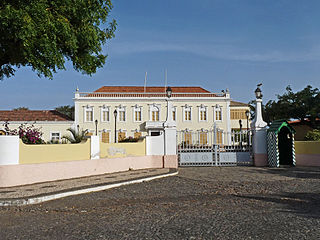
Plateau is the historic centre of the capital city of Praia in the island of Santiago, Cape Verde. It gets its name because it is situated on a plateau overlooking the port of Praia. Its average elevation is 37 meters above sea level. The population of Plateau was 1,019 at the 2010 census. Many public buildings are situated in Plateau, notably the Presidential Palace, the cathedral, the city hall and the Ethnographic Museum.
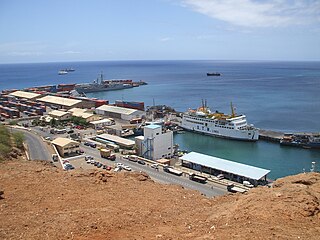
Praia Harbor is the port of the city of Praia in the southern part of the island of Santiago, Cape Verde. It is situated in a natural bay of the Atlantic Ocean. Since the latest modernization in 2014, it has 2 long quays, 3 shorter quays, a quay for fishing boats with fish processing installations, 2 container parks, 2 roll-on/roll-off ramps and a passenger terminal. The total length of the quays is 863 m, and the maximum depth is 13.5 m. The port of Praia played an important role in the colonization of Africa and South America by the Portuguese. With 817,845 metric tonnes of cargo and 85,518 passengers handled (2017), it is the second busiest port of Cape Verde, after Porto Grande (Mindelo).
The following is a timeline of the city of Praia, capital of Cape Verde.
The Culture of the Island of Santiago, Cape Verde is the richest in the nation, with a range of customs and practices common in the islands,

The Architecture of Cape Verde has different architectural styles in the nation. Unlike the African mainland, Cape Verde was uninhabited until 1461 when the Portuguese arrived, most of the other islands were first inhabited after the end of the 15th century. Its architecture was introduced in the 1460s and has its first origins from Portuguese settlers from the Madeira Islands, after the first arrival of mainland Africans, a bit of African architecture would be elements mainly in rural areas. The Manueline was its first architectural style on the island, it was later followed by Renaissance, Baroque, Pombaline, Early Modern and Modern. It was one of the last in the whole of Africa to introduce architecture late. Cape Verde has one of the richest architecture in the western portion of West Africa, the sub-Saharan portion, the richest probably being Mali.

São Martinho Grande is a settlement in the southern part of the island of Santiago, Cape Verde, and part of the municipality Ribeira Grande de Santiago. It is 4 km east from Cidade Velha and 6.5 km west of Praia city centre. National road EN1-ST05 passes north of it. 1.5 km to its south is Calheta de São Martinho, a small bay of the Atlantic Ocean. It was mentioned as "Kalyete de S. Martin" on the 1747 map by Jacques-Nicolas Bellin.

















